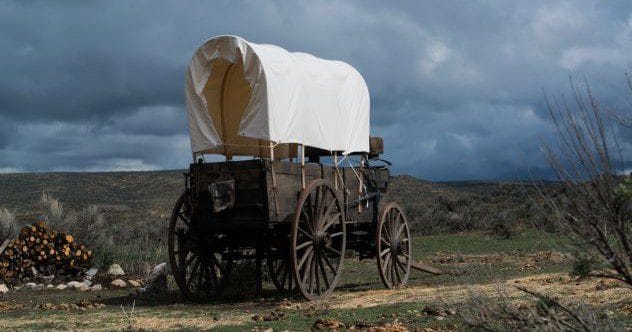Many of us picture the Old West through a romantic lens, perhaps from playing ‘The Oregon Trail’ or watching classic Westerns. Covered wagons are a central image in this picture, symbols of adventure and new beginnings. But what was it truly like to journey west in one of these iconic vehicles before railroads crisscrossed the continent? The reality was far from romantic; it was a brutal test of endurance. Forget easy rides and scenic views – traveling by covered wagon was an arduous, life-altering ordeal. Let’s pull back the canvas and explore ten harsh truths about these pioneering journeys.
10. A Grueling Journey: Months of Endless Misery
Imagine spending half a year just to reach your new home. That was the stark reality for many pioneers. Covered wagons moved incredibly slowly, typically covering only 8 to 20 miles on a good day. On flat land with fair weather, they might achieve that 20-mile top speed. However, treacherous mountains, severe weather, or dangerous territories could slow their pace to a mere crawl.
Consider a journey from St. Louis, Missouri, to San Francisco, California. Even if a wagon managed a steady 20 miles daily over a direct route of 1,750 miles, the trip would take nearly three months. But pioneer trails were rarely direct, and perfect travel days were few and far between.
In truth, most westward treks by covered wagon lasted up to six long, grueling months. Sickness, serious injuries, and even death were common occurrences. Those who finally reached their destination were fortunate, having sacrificed a significant portion of their lives to this challenging passage.
9. Choosing Your Chariot: Prairie Schooner or Conestoga
Pioneers heading west typically had two main types of wagons to choose from. The most iconic was the prairie schooner, familiar to many from games like ‘The Oregon Trail’. These wagons featured large, curved hoops covered by a canvas top, providing some shade for the supplies packed beneath. They were named prairie schooners because, from a distance, their white tops resembled ships sailing across the plains.
The second option was the Conestoga wagon. These were larger, heavier, and required a team of up to six horses. Due to their size, Conestogas were better suited for shorter distances and hauling heavy freight, rather than long cross-country journeys. Settlers moving to nearer territories like Kansas or Oklahoma often used them.
Regardless of the type, all wagons faced immense challenges. Roads were unpaved, and harsh weather often made existing trails nearly impassable. Broken wheels were frequent, animals collapsed from exhaustion, and wagons often got stuck in mud or damaged during difficult stretches.
8. No Room to Sleep: Camping Under the Stars
You might picture pioneer families cozied up inside their covered wagons at night. However, this was rarely the case. Prairie schooners were surprisingly small, typically only about four feet wide and nine to ten feet long. This limited space was crammed full of all their worldly possessions, leaving no room for sleeping.
As a result, families usually slept outside, under the open sky. They might set up a simple tent if they had one, but often they slept on the hard ground, sometimes directly beneath the wagon for minimal shelter. Imagine trying to get a restful night’s sleep in such conditions, especially during bad weather! It certainly wasn’t a comfortable way to end a long day of travel.
7. Trailside Dining: The Essential Chuck Wagon
While prairie schooners carried a family’s belongings, they weren’t designed for easy access to food. Supplies were packed tightly for the long haul. This is where the chuck wagon came in. Roughly the same size as a prairie schooner, the chuck wagon was the mobile kitchen of the trail.
These wagons were specially equipped. They often had a water barrel mounted on the side and sometimes a coffee mill for a much-needed caffeine boost. A key feature was the ‘possum belly’, a sling underneath the wagon used to carry firewood or cow chips for fuel. Each evening, the chuck wagon became the heart of the camp as settlers gathered to cook, eat, and share stories.
6. Beasts of Burden: Oxen and Mules, Not Horses
When we think of the Old West, images of cowboys on horseback often come to mind. While horses were vital for Native American tribes and soldiers, they were not the primary animals used by settlers pulling covered wagons. Horses were expensive to buy and maintain, a luxury most pioneers couldn’t afford.
Instead, settlers relied on oxen or mules. These animals were cheaper, hardier, and more durable than horses for the grueling task of pulling heavy wagons across vast distances. They could also survive on poorer quality grazing. Once families reached their destination, these same oxen and mules were put to work on the farm, making them a practical choice for pioneers.
5. Battling the Elements: Weatherproofing Your Wagon
Inclement weather was a constant enemy on the westward trails. The canvas tops of prairie schooners needed significant preparation to offer any real protection. Typically made from cotton duck fabric, the canvas was treated with linseed oil to make it mostly waterproof. It was then stretched over the wagon hoops and tied down securely.
However, rain rarely falls straight down, especially on the open prairies where winds are relentless. Storms could drive rain sideways, and on clear days, wind could whip up choking clouds of dust and sand. To combat this, settlers often sewed drawstrings into the ends of the canvas cover. This allowed them to pull it tightly closed, much like a giant hoodie, offering better protection against the harsh elements.
4. A Bumpy Ride: No Suspension, Constant Jolting
Pioneer trails were far from smooth, and covered wagons had no suspension systems. This meant an incredibly jarring and turbulent ride. Wooden wheels on wooden axles meant constant bouncing and shaking for hours, days, and weeks on end. Prairie schooners were also tall and narrow, making them top-heavy and prone to tipping, no matter how carefully they were packed with heavier items at the bottom.
As difficult as prairie schooners were, the larger Conestoga wagons could be even worse. Their wider and longer design made them more susceptible to tipping and struggling on narrow trail sections. To avoid the relentless jolting, many family members chose to walk alongside the wagon. However, walking hundreds or thousands of miles was its own exhausting ordeal.
3. On-the-Spot Repairs: Breakdowns Were Inevitable
There were no roadside assistance services on the pioneer trails. When a covered wagon broke down, families had to rely entirely on their own skills and resources. This meant carrying a hefty supply of tools and spare parts, or improvising with whatever materials they could find in the wilderness.
Wooden wheels frequently split, metal axles snapped, and other parts wore down or broke off on the rough terrain. Fixing these issues was a difficult and time-consuming process. Often, to make necessary repairs underneath the wagon, settlers had to unload all their possessions and tip the entire wagon on its side – a backbreaking task, especially in potentially dangerous territory.
2. Treacherous Waters: Perilous River Crossings
Sooner or later, all westward trails encountered rivers or streams. Even in the drier western landscapes, river crossings were an unavoidable and often terrifying part of the journey. These crossings were incredibly hard on families, their animals, and their wagons.
Larger rivers sometimes had ferries, but these charged a fee. Most often, pioneers had to ford rivers on their own. For smaller rivers, they might build makeshift rafts if timber was available. The crucial step was finding the safest point to cross – where the river was narrowest and the current calmest. They would then caulk their wagon beds with tar or wax to make them as watertight as possible, hoping they would float. The oxen or mules would then pull the semi-buoyant anachronistic_boat across. Success meant relief, but failure could mean losing everything.
1. Unwavering Spirit: The Drive to Push Onward
Despite all these brutal obstacles, the determination of the pioneers is remarkable. The dream of a new, better life through homesteading fueled their arduous journeys. Families of all ages, from young children to elderly grandparents, undertook these perilous treks, dramatically changing the American landscape and ushering in an era of ‘Manifest Destiny’.
Their westward movement had profound consequences, including the tragic displacement of Native American populations. As the pioneers forged these difficult paths, they paved the way for future developments like the Transcontinental Railroad. By the late 19th century, coast-to-coast travel became much easier, but it was these early settlers in their covered wagons who, through sheer grit and often at great personal cost, truly opened the West.
Traveling west by covered wagon was an incredibly challenging chapter in American history. These ten realities paint a stark picture of the daily struggles, dangers, and immense sacrifices pioneers faced. From the sheer length of the journey to the constant threat of breakdowns and the unforgiving elements, life on the trail demanded unimaginable resilience. Yet, despite these brutal conditions, thousands pushed onward, driven by hope for a new life and shaping the future of a nation. Their determination in the face of such adversity is a powerful testament to the human spirit.
Which of these covered wagon realities surprised you the most? Did you learn something new about pioneer life? Share your thoughts in the comments below!










